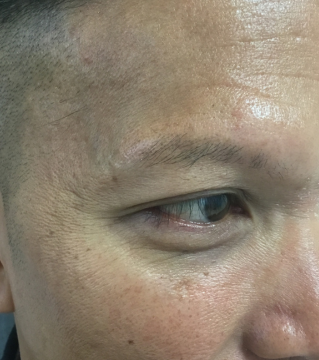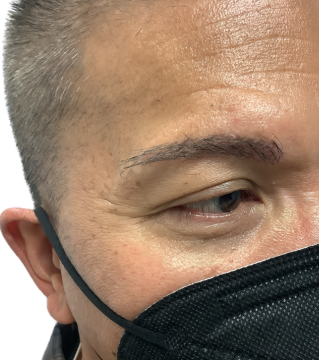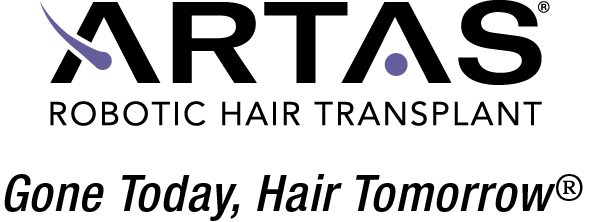Eyebrows
Eyebrow Transplant & Restoration
Eyebrow Transplant & Restoration
Eyebrows are a critical facial feature that helps to define the way we look. Due to their central position on the face, eyebrows serve to frame the eyes (the single most important facial element) and give insight into our facial expressions. Unlike the loss of scalp hair, the loss of one’s eyebrows is not viewed as a natural process and is, therefore, not cosmetically acceptable.
Eyebrows may be lost for a variety of reasons including thyroid and other systemic diseases, alopecia areata, burns, tattoos, infections, repeated plucking, congenital inability to grow eyebrows and a genetic tendency for eyebrows to thin, or disappear, over time.
Eyebrow Transplant Before and After


An eyebrow hair transplant is similar to other hair transplantation procedures performed on the scalp, in that, for appropriate candidates, the transplanted hair is permanent. However, because eyebrows have their own unique attributes, eyebrow transplants differ from hair transplants in a number of important ways.
Eyebrow Anatomy and Physiology
The direction of eyebrow hair changes dramatically in different parts of the brow. In the region of the eyebrow nearest the nose, the hair points upward. The hair across the top of the eyebrow points outward and downward. The hair in the lower part of the brow grows outward and upward. This crisscross growth pattern causes the hairs in the middle of the eyebrows to converge and form a subtle natural elevation running horizontally through the middle of each eyebrow.The second distinctive characteristic of eyebrow hair is that the hairs emerge from the follicle at a very acute angle so that the hair grows flat to the skin’s surface. This is in contrast to scalp hair where the angle between the hair and scalp can be 45 degrees.
The third important feature of the eyebrows is that the hairs grow as individual strands, rather than in the 1- to 4-hair follicular unit grouping that are characteristic of scalp hair.
The fourth distinctive element of eyebrow hair is that the hair growth cycle is very short. This means that eyebrow hair will grow (in anagen) only for about 4 months before it enters the resting (telogen) phase and falls out. In contrast, scalp hair has a growth phase that can last 3 to 7 years, enabling the scalp hair to grow much longer.
Eyebrow Transplant Technique
The most important aspect of transplanting eyebrows is to follow the natural hair direction very closely. This entails very subtle angle changes to recreate the fan-like splay of hair at the medial aspect of the brow and the converging hair direction as one moves laterally along the brow. Most importantly, the recipient sites for the hairs should be made with a very fine needle or blade that literally slides along the surface of the skin as the sites are being made, as this will insure that the hair will lie as flat as possible on the surface of the skin as it grows.
Another important part of an eyebrow transplant is that only individual hair follicles can be used. Since the scalp naturally consists of 1 to 4-hair follicular units, hair taken from this area must be divided up into 1-hair grafts using a stereomicroscope.
Cosmetic Results of an Eyebrow Transplant
Although eyebrow hair transplantation is a safe and cosmetically elegant procedure, there are a number of things to consider before undergoing this type of hair restoration. As with hair transplants to the scalp, the hair transplanted to eyebrows will continue to grow and must therefore be periodically cut. Besides being a minor nuisance, trimming the hair leaves a cut-end that is not as delicate as the fine-tipped end of an untouched hair.
In the process of healing, all wounds contract. As the recipient sites contract, they may slightly change their flat orientation and sometimes result in eyebrow hair that is slightly more elevated than one would like.
In contrast to hair transplants, where the donor hair is taken from another part of the scalp and matches perfectly, with brow transplants the hair is taken from a part of the body other than the eyebrows and will thus have slightly different characteristics with regard to both growth rate and appearance. If they are different, then over time, the transplanted scalp hair will slowly begin to approximate the growth pattern and characteristics of the existing eyebrow hair – but it may never totally match it.
The appearance of an eyebrow transplant will mature over the course of a year. At that time, an additional eyebrow hair transplant procedure may be considered. During this interval, the eyebrow can be tweezed and shaped as needed.
Frequently Asked Questions About Eyebrow Transplants
Anyone experiencing thinning in their eyebrows is suitable for an eyebrow hair transplant. If you have certain underlying conditions — such as bleeding or clotting problems — please consult your physician before pursuing eyebrow replacement procedures.
Eyebrow graft locations can vary depending on gender and the extent of your eyebrow loss. For women, the healthy follicles are generally taken from behind the ears or the area on the upper thighs. For men, the follicles can come from virtually anywhere on the body, depending on the thickness of the existing eyebrow hairs. Either way, the procedure is expected to take between 50-100 follicles — or more if you are experiencing extreme eyebrow loss.
The extent of your eyebrows that need to be replaced will affect the total operation, but you can expect it to take between five and six hours. Eyebrow hair transplants are outpatient procedures, meaning patients can go home the same evening.
Because eyebrow transplants are outpatient treatments, little to no downtime is required. However, you will need to perform regular maintenance to train the new hair follicles around your existing eyebrows. For example, you may need to trim the transplanted hair as it may grow faster than your natural eyebrows. Its growth rate should adjust over time.
Around three to five weeks after surgery, some shedding can occur — this is very normal. After that, you will see noticeable growth at around four to six months, and your eyebrows should be restored to their former glory by 10 months.
While most patients see success, keep in mind that unsatisfactory results can happen. Every situation is different and can vary depending on each patient’s condition and compliance with the program.
When successful, eyebrow hair transplants are permanent. The transplanted hair follicles grow to fill in your brows, creating natural and long-lasting results.
console.log( 'Code is Poetry' );


